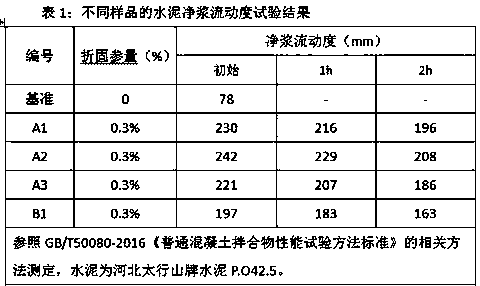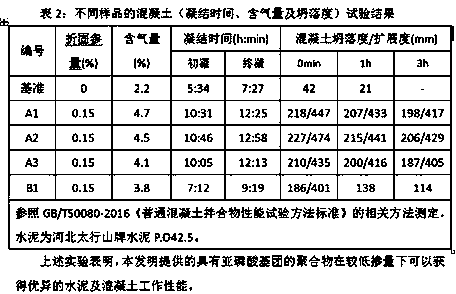Preparation method of (2-propylidenephosphonic acid)malonic acid
A technology of malonic acid and phosphonic acid, which is applied in the field of fine chemicals, can solve the problems of adaptability limitation, reduce the performance of water reducer, reduce the effective carboxyl group and phosphorus content of polycarboxylate water reducer, and reduce the unit dosage , high slump retention, outstanding retarding effect
- Summary
- Abstract
- Description
- Claims
- Application Information
AI Technical Summary
Problems solved by technology
Method used
Image
Examples
Embodiment 1
[0023] Step 1: Add 180g of absolute ethanol, 122g of isopropenephosphonic acid, 104g of malonic acid and 0.61g of sodium ethoxide into a 500ml round bottom glass flask in sequence, start stirring and reflux condensed water, heat to reflux state, and keep reflux state Reaction 4.06 After h, cool down and filter to obtain 403.1 g of filtrate.
[0024] Step 2: Transfer the filtrate into a 1L three-necked round-bottomed glass flask, add 1.22g red phosphorus as a catalyst, check the airtightness of the reaction system and after the test is qualified, start the stirring and tail gas absorption device, heat to reflux, and 85.2g chlorine gas According to the flow rate of 21.2g / h, it is slowly passed under the liquid surface. After 4.02h, the chlorine gas is passed through, and after the reflux reaction is continued for 30min, the temperature is lowered to 35°C.
[0025] Step 3: Slowly add a mixture of 204g sodium hydroxide and 280g calcium oxide under stirring, start stirring, heat up...
Embodiment 2
[0027] Step 1: Add 162g of absolute ethanol, 122g of isopropene phosphonic acid, 109g of malonic acid and 0.61g of sodium ethoxide into a 500ml round bottom glass flask in sequence, start stirring and reflux condensed water, heat to reflux state, and keep reflux state Reaction 4.04 After h, cool down and filter to obtain 388.7 g of filtrate.
[0028] Step 2: Transfer the filtrate into a 1L three-necked round-bottomed glass flask, add 2.44g red phosphorus as a catalyst, check the airtightness of the reaction system and after the debugging is qualified, start the stirring and tail gas absorption device, heat to reflux, and 106.5g chlorine gas According to the flow rate of 21.3g / h, it is slowly passed under the liquid surface. After 5.0h, the chlorine gas is passed through, and after the reflux reaction is continued for 30min, the temperature is lowered to 37°C.
[0029] Step 3: Slowly add 220g of sodium hydroxide and 280g of calcium oxide mixture under stirring, start stirring, ...
PUM
| Property | Measurement | Unit |
|---|---|---|
| quality score | aaaaa | aaaaa |
| quality score | aaaaa | aaaaa |
Abstract
Description
Claims
Application Information
 Login to View More
Login to View More - R&D Engineer
- R&D Manager
- IP Professional
- Industry Leading Data Capabilities
- Powerful AI technology
- Patent DNA Extraction
Browse by: Latest US Patents, China's latest patents, Technical Efficacy Thesaurus, Application Domain, Technology Topic, Popular Technical Reports.
© 2024 PatSnap. All rights reserved.Legal|Privacy policy|Modern Slavery Act Transparency Statement|Sitemap|About US| Contact US: help@patsnap.com









